Woodhouse Grove School
Woodhouse Grove School ('The Grove') is an independent, co-educational, day and boarding public school and Sixth Form. it is located to the north of Apperley Bridge, West Yorkshire, England (Apperley Bridge is located in the City of Bradford, however the school is located just over the municipal border in the City of Leeds). The school, and its preparatory junior school, Brontë House, is located in the Aire Valley.[3] There are approximately 1,000 students on roll, currently including around 90 boarders.
| Woodhouse Grove School | |
|---|---|
 | |
| Address | |
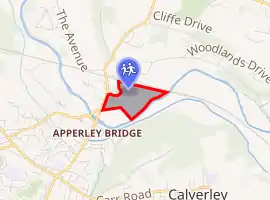
| |
Apperley Lane , , BD10 0NR England | |
| Information | |
| Type | Independent Day and Boarding School |
| Motto | Bone et Fidelis (Trans: Good and Faithful) |
| Religious affiliation(s) | Christian but also accepts children of other religions or Secular and non denominational children |
| Established | 1812 "Old Foundation" 1883 "New Foundation" |
| Founder | Adam Clarke and the Wesleyan Conference |
| Local authority | Bradford Leeds [lower-alpha 1] |
| Department for Education URN | 108114 Tables |
| President | Mr GB Greenwood |
| Chair of Governors | Alan Wintersgill |
| Headmaster | James Lockwood |
| Gender | Co-educational |
| Age | 11 to 18 |
| Enrolment | 721 (including 94 Boarders) |
| Houses | Atkinson Findlay |
| Colour(s) | Green, Maroon, Red |
| Publication | News From The Grove[2] and The Grovian |
| Former Pupils | Old Grovians |
| Feeder preparatory school | Brontë House Junior Prep School |
| Pre School Facility | Ashdown Lodge School |
| Website | http://www.woodhousegrove.co.uk/
|

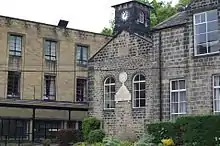

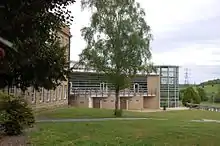
The school was founded as an all-boys boarding preparatory institution, for the sons of Methodist Ministers. It developed over the latter part of the 20th century. Woodhouse Grove has evolved into an independent education centre, providing education from the age of three through to graduation from the sixth form.
Although a Christian school, Woodhouse Grove accepts children from other religions or children with no declared religious affiliations. The school offers academic and sixth form scholarships, bursaries for HM Forces families, clergy families and sixth form, music awards, sport awards and financial assistance for siblings.
Location
The school is located in a rural setting close to the metropolitan centres of Leeds, 10 miles (16 km) distant and Bradford, 4 miles (6 km) away. Leeds Bradford International Airport is approximately 3 miles (5 km) north-east of the school. The school benefits from the Apperley Bridge railway station, opened in 2015, which is located just across the road from the school's chapel.
History
Early plans
Kingswood School, near Bath, in the West Country, served as the sole Methodist school from 1748, but was inconvenient for northern residents. The topic was raised at Conference in 1781 and John Wesley replied, "Probably we may (provide such a school). Let our brethren think of a place and a master and send me word".[4] Adam Clarke returned to the subject at the 1806 conference, in his first year as conference president.[5] Over the next five years possible sites were examined.
The Grove
With the purchase at Woodhouse Grove in Apperley, near Bradford, the decision to found the school was made by ballot at the Wesleyan Conference of 1811, still under Clarke.[6] It initially provided an education for the sons of the itinerant ministers in service of the Wesleyan Methodist Church in the north of England. The original name, The Wesleyan Academy, as evidenced by a commemorative wall plaque at the school, did not catch on.
Few alterations were needed to convert the house for use as a school, but the barn was cleaned up as a schoolroom and the stables converted as a chapel. The drawing room became a lecture and study room and thirty wooden cribs (or cots) were provided for the boys to sleep on. The school opened on 8 January 1812 under the headship of John Fennell as first master and with an initial roll of twenty seven pupils.[7]
For much of the 19th century, between 1812 and 1875, Woodhouse Grove and Kingswood operated as separate schools for children aged between eight and fifteen years old, with both schools under direct control of conference. The school also had a local management committee and there were frequent conflicts with conference over duplicated but differing decisions relating to teacher selection, staff salaries and building expansion needs. Between 1875 and 1883, the two schools were combined as a single school, despite the problems caused by being two hundred miles apart. The Grove served as a preparatory school with pupils then relocating at the age of thirteen to the upper school at Kingswood.[8]
The school was refounded on 21 September 1883, the "New Foundation Day", to admit boys from a wider spectrum of backgrounds. The Grove received its first pupils as a Methodist middle class boarding and day school under a new policy laid down by the Wesleyan Conference.[9][10] The sermon on the New Foundation Day was given by the Reverend Robert Newton Young, himself a former pupil of the school between 1837 and 1843, and the sermon was based around the text “Bone et Fidelis” or “Good and Faithful” which was to become the new school motto to the present day.[11]
By the summer term of 1884, the school roll had expanded to 155 pupils. During the Second World War, and under direct grant funding after the 1944 Education Act, the school expanded, with boarding pupils placed and paid for by London County Council and the East Riding of Yorkshire authority.[12]
Traditionally a school for boys only, the school first admitted girls to the sixth form in 1979 and has been fully co-educational since 1985. The school has continued to expand since its origins, adding modern buildings as required almost continuously over its existence. The school originally sat in a few acres of semi-rural land but now extends over 70 acres (0.28 km2) of playing fields, riverside and woodlands.
Brontë House
For several years, HM Inspector of Schools had recommended that Woodhouse Grove make better provision for younger pupils. Under the guidance of the Secretary of the Methodist Education Committee, Rev. H. B. Workman, the preparatory school at Brontë House was founded in 1934 as a junior preparatory school for five- to eleven-year-old boys. The school became a coeducational establishment in 1985.[13]
The school stands in the grounds of a former private residence called Ashdown House and was originally known as 'Woodhouse Grove Preparatory School'. Ashdown House stood in the grounds of an older mansion known as Upperwood House where Charlotte Brontë was once governess to the White family's two children. The first master of the new school was Dr F.C. Pritchard MA, who later wrote the 1978 history of the school and its development.[13] Charlotte Brontë's father, the Reverend Patrick Brontë, had met Maria, his wife to be, while visiting his friend, John Fennell, who became the first headmaster of the Grove in the early 19th century.
Initially, Brontë House had no kitchen facility of its own and the children were escorted back and forth in all weathers to the Grove for their lunches and dinner. Later, a small car was bought by the school to ferry prepared meals from the main school kitchen to Brontë House,[14] until a proper kitchen was built several years later. A boarding facility is provided for pupils.
Ashdown Lodge
Ashdown Lodge opened in September 1993, as the Early Years Department of Woodhouse Grove, providing continuity of education from three to eighteen years of age.
Current school
The school consists of three symbiotic parts:
- Ashdown Lodge (Nursery) — situated quarter of a mile from the Grove, is the Early Years department of Woodhouse Grove, for pre-school children aged between three and five. The nursery provides full day and part-time morning or afternoon sessions and is open all year except during the Christmas period. It also provides after-school care, and a local holiday play scheme.
- Brontë House (Junior) — for children aged between five and eleven is also a quarter of a mile from the Grove. Recent SATs results at ages seven and eleven regularly state Brontë House to be one of the top junior schools of the region, and there is automatic promotion to the Woodhouse Grove senior school. The headmaster of Brontë school is Simon Dunn. In 2014 there are 331 pupils registered as attending Brontë House.
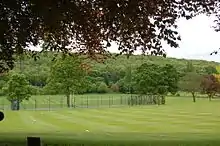

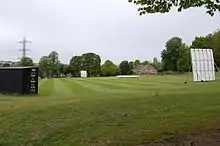
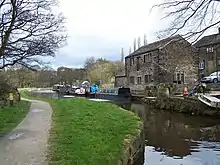
- Woodhouse Grove (Secondary and sixth form) — has facilities that include a sports and performing arts complex, and boarding accommodation.
The school has a broad intake, high academic standards and good examination results.[15] The effectiveness of sporting facilities has provided county and national representatives. There is a commitment to local community services and fund-raising activities.
The school has received financial investment over the last 15 years which has improved facilities. The Sports Hall and theatre complex was built in 2003 which was then followed by the addition of a Music and Performing Arts centre in 2009. A 25m competition pool Jubilee Swimming pool was completed at the time of the school's 200th year founding anniversary. 'The Grainge' is an all-weather pitch named after Old Grovian George "Leslie" Grainge who was at the school in the 1920s and later went on to be a professional Rugby player.
Boarding
Boarding arrangements are occasional, weekly or full. Day pupils take activities that are provided for those that board. Boarding accommodation consists of two houses: Brodwell House for boys, which was purpose-built in 2006, and Miller House for girls in the old part of the school. Activities are arranged for boarding pupils at weekends.
Badge
The school badge is an Escutcheon (or shield) bearing a Party per cross division of the field in Argent (or silver) that represents both the 'Cross of Christ' and 'Peace'.
The tincture (or colour) of two quadrants is Gules (or red) that represents 'Courage and magnaminity'. The remaining quadrants have a tincture of Vert (or green) that stands for 'Hope and Joy'.
An Escallop (or sea shell) usually represents 'St James' or is symbolic of a 'pilgrimage to a foreign land'. Also because, once separated, a shell cannot be rejoined it also represents 'Fidelity'. Where shown in a group of three the escallops usually represent 'Crusader grants' for three separate Holy Crusades to Galilee.
The castle Keep is the strongest part of a castle and represents the 'strength of the church'.
The open Bible is the basic book of learning and here it shows both faith and the 'search for knowledge'.
Notable staff
Former Manchester United Footballer and Yorkshire and England cricketer, Arnie Sidebottom, was a cricket coach at the Grove. and Joe Bedford, former Leeds Carnegie rugby player coming from the junior school Brontë house.
Notable alumni
The Old Grovian Association currently has 3,600 members from previous students and staff. Notable alumni include:[16]
- Sir Albert Newby Braithwaite DSO (2 September 1893 – 20 October 1959) was a British Conservative Party politician.
- John William Draper (1811–1882), chemist, botanist, historian and photographer
- Anna Fitzpatrick (1989– ), tennis player
- George Leslie "Les" Grainge (1910–1983), rugby league footballer of the 1930s for England, and Bradford Northern
- John Anderson Hartley (1844–1896), educationist
- John Hillaby (1917–1996), travel writer
- Thomas Hocken (1836–1910), collector, bibliographer and researcher
- Nick Houghton (1954– ), General Sir John Nicholas Reynolds Houghton KCB, CBE was the Chief of the Defence Staff of the British Armed Forces (2013–2016).
- John Lockwood Kipling (1837–1911), illustrator, museum curator
- Peter Brierley Johnson (1925–2016) correspondent reuters, BBC
- Kathryn Leng (1985–), cricketer
- Herbert Edward Palmer (1880–1961), poet
- George Northcroft (1885–1943), British Orthodontist
- William Mabane, 1st Baron Mabane (1895–1969), Liberal politician, held office as Assistant Postmaster-General and Minister of State for Foreign Affairs.
- Uzair Mahomed (1987–), cricketer
- Katie O'Brien (1986– ), tennis player
- Naomi Broady (1990– ), tennis player
- John Poulson (1910–1993), Architect
- George Scott Railton (1849–1913) Leader of The Salvation Army with William Booth, and father of David Railton and grand father of Dame Ruth Railton
- Samuel Evans Rowe (1834–1897), Methodist missionary to South Africa
- Paul Sampson (1977– ), rugby player
- Dan Scarbrough (1978– ), rugby player
- Ajmal Shahzad (1985– ), cricketer
- Joe Bedford (1984– ), rugby player
- Eni Gesinde (1982– ), rugby player
- Noel Stockdale (1920–2004), businessman and co-founder of Asda
- Edward Sugden (1854–1935), Methodist and first master of Queen's College (University of Melbourne)
- Michael Walker (1944– ), now Baron Walker of Aldringhan, was Chief of the Defence Staff (CDS) in the United Kingdom from May 2003 until April 2006.
- Aasif Mandvi (1966– ) Actor
- Jessica Knappett (1984– ) Writer and actor
References
- Houses - General information
- Woodhouse News
- Description of school
- [The Story of Woodhouse Grove by F.C. Pritchard 1978 – Privately published ASIN: B0006D1JSS – Page 2]
- [The Story of Woodhouse Grove by F.C. Pritchard 1978 – Privately published ASIN: B0006D1JSS – Page 4]
- [The Story of Woodhouse Grove by F.C. Pritchard 1978 – Privately published ASIN: B0006D1JSS – Page 7]
- [The Story of Woodhouse Grove by F.C. Pritchard 1978 – Privately published ASIN: B0006D1JSS – Page 9]
- [The Story of Woodhouse Grove by F.C. Pritchard 1978 – Privately published ASIN: B0006D1JSS – Preface page xii]
- [The Story of Woodhouse Grove by F.C. Pritchard 1978 – Privately published ASIN: B0006D1JSS – Page 205]
- Opening up of the school
- [The Story of Woodhouse Grove by F.C. Pritchard 1978 – Privately published ASIN: B0006D1JSS – Page 217]
- [The Story of Woodhouse Grove by F.C. Pritchard 1978 – Privately published ASIN: B0006D1JSS – Page 328]
- [The Story of Woodhouse Grove by F.C. Pritchard 1978 – Privately published ASIN: B0006D1JSS – Page 317]
- [The Story of Woodhouse Grove by F.C. Pritchard 1978 – Privately published ASIN: B0006D1JSS – Page 319]
- BBC Results table
- Old Grovian website